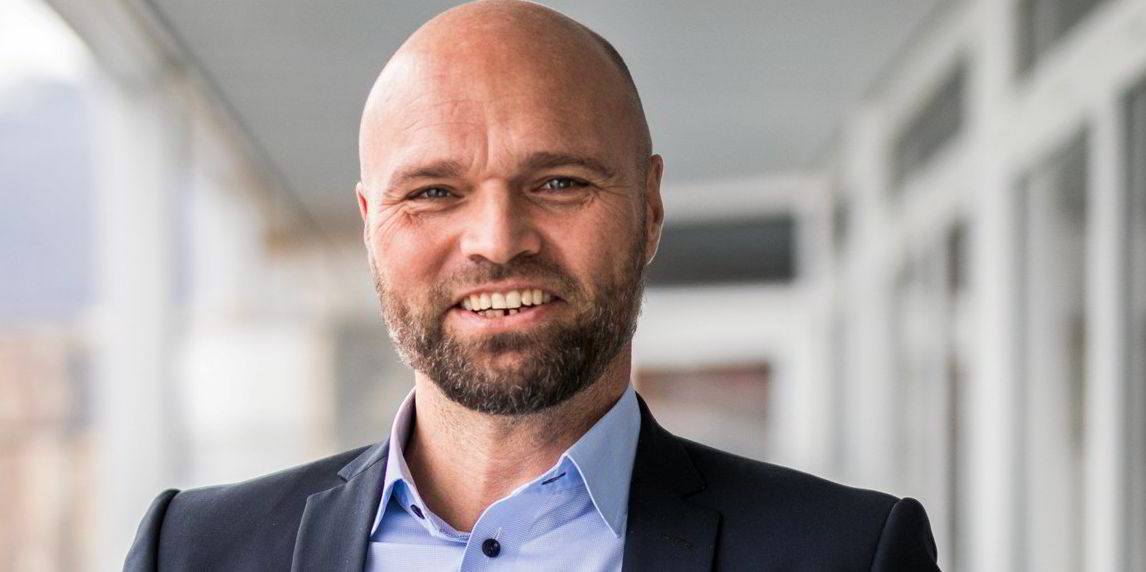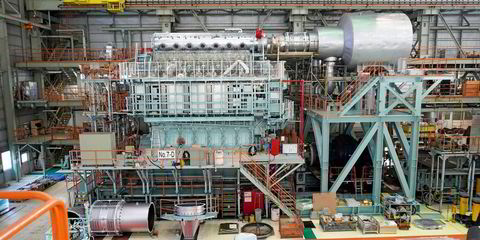Retrofitting bulkers to run on ammonia is still too expensive, supply of the fuel is in its infancy and the unclear regulatory backdrop is hindering progress.
Those are the key conclusions following a trial of green ammonia fuel on board open-hatch bulk carriers carrying pulp cargoes on transatlantic voyages.
It is hoped that the publication of a report on Tuesday will engage the wider industry to help figure out how these obstacles might be overcome.
The pilot project, which kicked off early last year, was initiated by Norway’s Green Shipping Programme and looked at how ammonia could be used on supramaxes operated by Grieg Star.
“It was not surprising to find that it was technically doable. But we were a bit surprised about how extensive and complex the technical work will be,” Atle Sommer, managing director of Grieg Star, told TradeWinds.
“We also found that the operational rules and regulations are in place to do it. On the other hand, we find a lack of plans and strategy in the ports for supply of green fuels.”
Grieg Star aimed to find out whether it would be viable to retrofit its 11 L-class, 50,000-dwt open-hatch bulkers to run on green ammonia.
The fuel could still be an option for the fleet in the future, but for now, there are still too many barriers to retrofitting vessels, Sommer said.
“The high-level main barrier we find is the combination of high retrofit investment cost, the lack of availability of competitively priced green ammonia and the unclear effects of regulatory frameworks,” he said.
“The first one — the high retrofit investment cost — we find that’s about 50% of the asset value.”
The estimated retrofit cost is $22m, nearly half of which relates to modifications to the main engine, based on Grieg’s L-class bulkers. The fair market value of an L-class vessel was $35m at the end of 2021.
Retrofitting will increase the cost base of operating vessels, depending on the financing structure, according to the report. “Positively, the benefits of using ammonia can be substantial and offset part of this cost increase,” it said.
The study found the savings in greenhouse emissions can be significant — estimated at 75%.
“Lower emissions reduce carbon tax and the need to slow steam, hence tighter regulations are positively affecting the investment case (and also reduces ‘stranded asset’ risk),” the report notes.
But to make such large investments, visibility of the future trading environment is needed to lower risk. This remains tricky with existing regulations.
“Broadly, there seems to be a missing link between the requirements and the facilitation, so to speak, in regulations and available energy,” Sommer said.
Major investments are being held up because the future effects and outcomes of the Carbon Intensity Indicator (CII) regulation remain unclear, the report highlighted.
“Having a framework that actually supports the entire value chain for getting production up and running for renewable ammonia or renewable hydrogen, that needs to be incentivised in a way that actually pushes volumes out into the industry,” Torleif Frimannslund, Grieg Star’s vice-president of technology & decarbonisation, told TradeWinds.
“Regulations for shipping specifically are challenging, often pointed towards EU ETS [Emissions Trading Scheme].
“ETS, for us, is easy to calculate. It’s easy to see the consequences of it and there’s very little insecurity about the consequences of moving in any direction. With CII, it’s much harder to understand.
“I think leaning on CII regulations to do investments is incredibly challenging.”
The study highlights that the availability of green ammonia is “paramount”.
But many ports are not ready to facilitate ammonia bunkering and there are no perfect solutions to putting supply in place.
Grieg Edge, the innovation arm of the Grieg Group, plans to begin distributing ammonia in southern Norway by the end of 2027, but this is years away.
Norwegian energy giant Equinor plans to begin producing blue hydrogen — but the production process creates CO2 emissions that must then be stored.
The study found that, with the current regulatory frameworks, it is not possible to finance “through traditional channels” the retrofit of an L-class bulker for ammonia and also remain compliant with CII.
Fuelling an L-class ship with ammonia would add an estimated $200,000 per year to operational expenses, but the study noted that precise estimates are hard to quantify.
These extra costs relate mostly to the maintenance of new systems, the need for specialised service engineers and dry-docking costs for the main engine.
Additional costs will need to be compensated for by reducing lost revenue days from slow steaming to remain compliant with regulations such as CII.
They can also be partly offset by preventing or limiting carbon tax, which increases the voyage cost. Two out of three of the transatlantic voyages modelled by the study will interact with the EU ETS.
The study began in 2022 and was initiated by the Green Shipping Program.
It looked at how ammonia could be used on three transatlantic voyages undertaken by L-class Grieg Star supramaxes transporting pulp. The bulkers currently run on very low-sulphur fuel oil.
The first leg modelled in the study is the 4,700 nautical miles (8,700 km) from Antwerp and Rotterdam in northern Europe to Houston and Mobile in the US Gulf.
The second 4,810-nautical-mile leg is from the US Gulf to ports in south-east Brazil.
The longest leg of all — and potentially the most challenging — is the 4,915-nautical-mile voyage from Brazil back to northern Europe.
Brazilian pulp and paper manufacturer Suzano, the world’s largest exporter of eucalyptus pulp and a charterer of open-hatch vessels for these cargoes, was a key participant in the study.
Other partners included Norway’s DNB Bank; Norwegian chemical company Yara International, a big producer of ammonia; classification society DNV; engine manufacturer MAN Energy Solutions; equipment giant Wartsila; and Chevron, a big supplier of lube oil.
The study examined five different workstreams comprising commercial, technical, infrastructural, financial and operational aspects.





